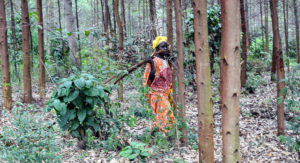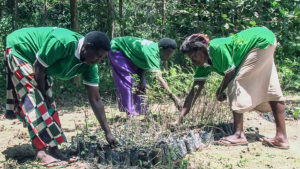
Aimed at enhancing women’s participation as well as identifying how negotiation and facilitation can strengthen women’s tenure, a gender-equity approach is showing better outcomes not only for women but also for forest resources.
The approach, dubbed Adaptive Collaborative Management (ACM), was outlined in a recent webinar by Esther Mwangi, Center for International Forestry Research (CIFOR) principal scientist and the CGIAR Research Program on Forests, Trees and Agroforestry’s (FTA) former gender lead.
In opening the discussion, Ewen Le Borgne of the CGIAR Collaborative Platform for Gender Research, which organized the webinar, foreshadowed how ACM can be used to foster increased gender equity in the management and use of community forests.
“Strengthening women’s rights is possible even when norms of patriarchy are strong,” he said. “[Mwangi] shows that strengthening women’s rights and decision-making has positive implications for the reforestation of degraded forests as well as for increasing on-farm tree planting.”
Mwangi, whose research focuses on forest governance issues, including gender, tenure, property rights, community participation and linking knowledge with action, presented the findings of work carried out in Uganda over a six-year period that ended in 2016.
Gender biases generated through cultural norms and practices are considered to be among the most common impediments to women’s rights to, and participation in the benefits of, forests and trees.
Customary norms regulate land and resource rights in many parts of Africa, with studies showing that such norms permeate into formal decision-making arenas where they can constrain the implementation of gender-equitable statutory provisions.
During the discussion, Mwangi questioned what tends to eventuate from policies, which are generally well-intended, particularly those aimed at promoting gender equity in the forestry sector. In Uganda, she explained, forest policy was very explicit about increasing the security of tenure over forest resources for women, as well as encouraging women and youth to actively participate in decision-making, resource management and benefit-sharing.

Interested by this policy, Mwangi examined the extent to which the good intentions were fulfilled in practice. She first presented the results of a situation analysis conducted in 18 communities in three districts in Central Uganda, which aimed to establish how men and women used and managed forest resources.
Mwangi discussed the nature of the relationship between men and women and their decision-making in relation to forest resources. She found that gender inequalities still exist in the sector, often due to cultural norms and practices at the community level, among many other reasons.
These norms can dictate who owns trees and forests, as well as who makes decisions about trees within community forestry groups and on farms.
“There was a clear bias against women,” she explained. “Women cannot plant trees. In particular, certain trees are considered taboo species, such as ficus.”
Ficus natalensis, also known as the natal fig, can be used for fodder and firewood, or as timber for furniture and boats. Ficus bark is also processed into barkcloth, used for traditional functions and burial ceremonies in Uganda, which can provide a source of income for processors.
Prior to the development of ACM, because of the existing cultural taboos surrounding the planting of ficus, women in Uganda were prevented from cultivating and deriving an income from the trees. However, the collaborative approach encouraged more women to negotiate with their husbands to allow them to plant ficus.
Read more: Forbidden no more: women negotiate changes in tree planting traditions
ACM enhances women’s participation and identifies how negotiation and facilitation can strengthen women’s tenure rights amid customary norms with a male bias, Mwangi explained.
“It involves voluntary groups that are facilitated in order to enhance communication, improve collaboration, resolve conflict and […] seek out ways of collectively learning about the impacts of their actions.”
It is ultimately about “enabling communities to deal with their own issues and their situation,” she said, which can improve equity, and “empower women and other marginalized groups to have a say in how forests are used and managed.”
Forest degradation and a decline in forest resources were key issues in the forest-adjacent communities, who found they could reduce pressure on forest resources with on-farm techniques such as tree planting, keeping bees and pigs, and water harvesting.
Within the process of implementing these priorities, women were facilitated to take on leadership positions, and participate and engage in more meaningful ways. Through ACM, women can contribute to discussion without fear of ridicule or retribution, Mwangi stated.

Mwangi looked closely at the application of the ACM approach among six randomly selected forest-adjacent communities in three districts in Central Uganda.
According to her, women in the communities expressed concern over exclusion from decisions despite their use and management of forests and trees; absence in leadership positions; poor attendance at meetings; a lack of confidence to speak up during meetings; and cultural norms that prevented them from planting, owning and economically benefiting from trees.
Before the approach, there were no women planting Ficus natalensis, due not only to the issues identified by the women, but also the taboos highlighted by the researchers surrounding the trees as land ownership symbols. Following the efforts, around one-third of the women involved began to plant the trees, while two women also began to sell barkcloth made from ficus.
Women also planted and owned more trees, were able to contribute equally to discussions, and took on more leadership positions.
Read more: Strengthening women’s tenure rights and participation in community forestry
Within these efforts, linkages to external actors were key, as they provided buffers, resources and legitimacy, and helped to identify new opportunities. Men in the communities were also important players in improving women’s rights.
“Men can be allies in processes of strengthening women’s rights and empowerment, and in fact mixed groups can be a viable pathway, in addition to women-only groups,” said Mwangi.
Statutory rights are not always automatically exercised or implemented, she explained, especially when cultural norms create roadblocks, which is why collaborative approaches are needed on the path to gender equity.
“Negotiation and facilitation by intermediaries can strengthen women’s rights and participation,” she said. “We can actually move from one set of norms to another, which allows women greater freedoms, allows them to take leadership, and be seen as legitimate leads in decision-making, resource allocation and resource access.”
This results not only in better outcomes for women, but also for forest resources and reforestation, she added.
By Hannah Maddison-Harris, FTA Communications and Editorial Coordinator.
This research forms part of the CGIAR Research Program on Forests, Trees and Agroforestry (FTA), which is supported by CGIAR Fund Donors.











